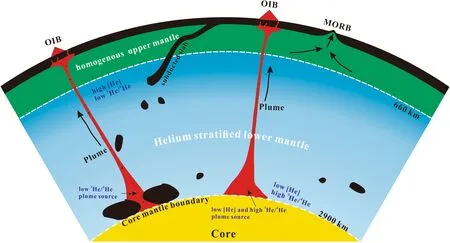Chemical structure of the Earth’s mantle defined by fast diffusion elements like helium
2020-04-26YunLiu
Yun Liu
A theoretical model and numerical simulation (i.e., Zhu et al. 2019)demonstrates that the Earth’s lower mantle was intrinsically stratified for helium (He) by thermal diffusion owing to adiabatic temperature gradient in the Earth. This finding helps to explain the two longstanding problems: the helium concentration paradox and the heathelium paradox.
Mass-dependent isotope fractionation of helium is believed to be too small to significantly change3He/4He isotopic ratios in geological processes, comparing with the change by radiogenic4He by α-particle (4He) decay of U and Th.In addition,He isotope fractionation caused by diffusion is expected to be also small,since D3He/D4He= 1.03(Shuster et al.2004),where D3Heand D4Heare diffusion coefficients of3He and4He, respectively. Thermal diffusion, also called the Soret effect, has been experimentally and theoretically proved to produce significant amount of elemental and isotopic fractionations (Huang et al. 2010; Li and Liu 2015; Richter et al. 2014; Walker and Delong 1982).However, confirmed natural large-scale processes with such effect have not been found, because mass diffusion rate is several orders of magnitude smaller than that of heat diffusion, thus mass diffusion could not achieve much fractionation before temperature gradient or contrast had vanished.
Therefore,mantle convection tends to homogenized any inhomogeneous reservoirs (Kellogg and Turcotte 1987;Ricard 2015), intrinsic adiabatic (convective) temperature gradient produced by convection is totally overlooked to generate any chemical fractionation. However, Zhu et al.(2019) shows that adiabatic temperature gradient can produce elemental and isotopic fractionations of helium in the lower mantle due to sluggish convection compared to fast diffusion of He.This can’t repeat itself in the upper mantle owing to faster convection. The highest3He/4He isotopic ratios and lowest He contents are located in the lowermost of lower mantle (Fig. 1), a helium stratified state can be maintained.Such unique chemical composition signals can be captured by super plumes which originates from the core-mantle boundary area. This modeling results of Zhu et al. (2019) therefore can explain the long-standing ‘helium concentration paradox’(Anderson 1998) (Fig. 1).
High3He/4He ratios in OIBs are often regarded as evidences for an undegassed mantle source sampled by plumes (Kellogg and Turcotte 1990; Kurz et al. 1982;Moreira 2013; Mukhopadhyay and Parai 2019). However,this conventional model can’t explain why helium concentrations are several orders of magnitude lower than in MORBs (Anderson 1998). This paradox has led to a longstanding controversy about the chemical structure and dynamics of the Earth’s mantle. Although many models have been proposed, such as the predegassing (Hopp and Trieloff 2008) and disequilibrium degassing models(Gonnermann and Mukhopadhyay 2007),the basal magma ocean model(Labrosse et al.2007),primordial noble gases in the core (Bouhifd et al. 2013; Porcelli and Halliday 2001), residue of melting (Class and Goldstein 2005; Parman et al. 2005), etc., it is still an open issue (Moreira 2013). Zhu and colleagues’ models are brand new and physically rational, and do provide some insights to solve this issue.

Fig. 1 Diagram demonstrating the intrinsically stratified lower mantle in helium concentration and isotope (Zhu et al. 2019). Helium stratification was established by thermal diffusion due to large temperature contrast across the lower mantle, and can’t be removed by the slow convection in the lower mantle. Therefore, super plumes arise from the deepest mantle have highest 3He/4He isotopic ratios and lowest He concentrations as observed in OIBs; while some plumes carrying recycled slab will show intermediate values. In contrast, the upper mantle is homogenous in helium because of its vigorous convection, resulting in a narrow range of 3He/4He ratios
Interestingly, Zhu and colleagues also claimed that the helium stratified mantle was formed in the early Earth,and would lead an over-degassed deepest mantle in He due to largest temperature contrast. Thus later evolution of the deepest mantle is helium ingassed process (Zhu et al.2019). The ingassed helium was probably radiogenic4He.This may help to explain the apparent imbalance of heat and helium released by the Earth, the heat-helium paradox(Onions and Oxburgh 1983). Zhu et al. (2019)’s model is still a hypothesis yet. Future experimental works are desperately needed to provide data about the helium’s behavior in the deep mantle.
Nevertheless,the new model by Zhu et al.(2019)will be of value in understanding the chemical structure the Earth’s mantle(Fig. 1).Moreover,extrapolation of the new models would suggest that fast diffusion components, such as hydrogen (Demouchy 2010; Hae et al. 2006), would be also enriched in their light isotopes in the deepest mantle.This is consistent with the case of lavas in Baffin Island,which have not only the highest3He/4He isotopic ratios found so far (Starkey et al. 2009; Stuart et al. 2003), but also the lowest D/H ratio (Hallis et al. 2015).
杂志排行
Acta Geochimica的其它文章
- A helium stratified and ingassed lower mantle: resolving the helium paradoxes
- Mechanism of accelerated dissolution of mineral crystals by cavitation erosion
- Zircon chemistry and new laser ablation U-Pb ages for uraniferous granitoids in SW Cameroon
- Zircon U-Pb age and geochemical constraints on the origin and tectonic implication of the Tuotuohe Cenozoic alkaline magmatism in Qinghai-Tibet Plateau
- Evaluation of the potential risks of heavy metal contamination in rice paddy soils around an abandoned Hg mine area in Southwest China
- Low-temperature alteration of uranium-thorium bearing minerals and its significance in neoformation of radioactive minerals in stream sediments of Wadi El-Reddah, North Eastern Desert, Egypt
